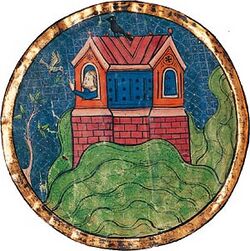Mountains of Ararat
Topic: Unsolved
 From HandWiki - Reading time: 4 min
From HandWiki - Reading time: 4 min
In the Book of Genesis, the mountains of Ararat (Biblical Hebrew הָרֵי אֲרָרָט, Tiberian hārê ’Ǎrārāṭ, Septuagint: τὰ ὄρη τὰ Ἀραράτ)[1] is the term used to designate the region in which Noah's Ark comes to rest after the Great Flood.[2] It corresponds to the ancient Assyrian term Urartu, an exonym for the Armenian Kingdom of Van.[3][4]
Since the Middle Ages the "mountains of Ararat" began to be identified with a mountain in present Turkey (historical Armenia) known as Masis or Ağrı Dağı; the mountain became known as Mount Ararat.[5][6]
History
Citing historians Berossus, Hieronymus the Egyptian, Mnaseas, and Nicolaus of Damascus, Josephus writes in his Antiquities of the Jews that "[t]he ark rested on the top of a certain mountain in Armenia, . . . over Minyas, called Baris."[7]
Likewise, in the Latin Vulgate, Jerome translates Genesis 8:4 to read: "requievitque arca . . . super montes Armeniae" ("and the ark rested . . . on the mountains of Armenia");[8] though in the Nova Vulgata as promulgated after the Second Vatican Council, the toponym is amended to "montes Ararat" ("mountains of Ararat").[9]
By contrast, early Syrian and Eastern tradition placed the ark on Mount Judi in what is today Şırnak Province, Southeastern Anatolia Region,[10] an association that had faded by the Middle Ages and is now mostly confined to Quranic tradition.[citation needed]
The Book of Jubilees specifies that the ark came to rest on the peak of Lubar, a mountain of Ararat.[11]
Sir Walter Raleigh devotes several chapters of his Historie of the World (1614) to an argument that in ancient times the mountains of Ararat were understood to include not only those of Armenia, but also all of the taller mountain ranges extending into Asia. He maintains that since Armenia is not actually located east of Shinar,[note 1] the ark must have landed somewhere in the Orient.[citation needed]
See also
- Armenian highlands
- Mount Ararat
- Mount Tendürek
- Searches for Noah's Ark
- River system of Mesopotamia
- Taurus / Zagros Mountains
Notes
- ↑ See Genesis 11:2 in the King James Bible, following the Septuagint: "And it came to pass, as [the descendants of Noah] journeyed from the east (Septuagint: ἀπὸ ἀνατολῶν),[12] that they found a plain in the land of Shinar; and they dwelt there." Ararat is in fact located to the northwest of Shinar; hence many translations depart from the Septuagint here, rendering the prepositional phrase as "eastward" or "to the east."[13] This discrepancy is discussed extensively in biblical commentaries[14][15] and elsewhere.[16]
References
- ↑ BIBLE - GENESIS 8:4. https://my.bible.com/bible/59/GEN.8.ESV.
- ↑ "Genesis 8:4". Online Parallel Bible Project. http://biblehub.com/genesis/8-4.htm.
- ↑ Lang, David Marshall. Armenia: Cradle of Civilization. London: Allen and Unwin, 1970, p. 114. ISBN:0-04-956007-7.
- ↑ Redgate, Anna Elizabeth. The Armenians. Cornwall: Blackwell, 1998, pp. 16–19, 23, 25, 26 (map), 30–32, 38, 43. ISBN:0-631-22037-2.
- ↑ Agadjanian, Alexander (15 April 2016). Armenian Christianity Today: Identity Politics and Popular Practice. Routledge. p. 14. ISBN 978-1-317-17857-6. https://books.google.com/books?id=YAYHDAAAQBAJ&pg=PA14. "It is worth noting that, contrary to Armenian Apostolic Church discourse and popular knowledge, it was probably as late as the beginning of the second millennium AD when the localization of the biblical Mount Ararat was permanently moved from the highlands hemming upper Mesopotamia to Mount Masis in the heart of historical Armenian territory."
- ↑ Petrosyan, Hamlet (2001). "The Sacred Mountain". in Abrahamian, Levon; Sweezy, Nancy. Armenian Folk Arts, Culture, and Identity. Indiana University Press. p. 36. ISBN 978-0-253-33704-7. https://archive.org/details/isbn_9780253337047/page/36. "When Armenians were first introduced to the biblical story of the flood, there was no special interest in the location of Mount Ararat. Most Armenian historians in the Early Middle Ages accepted the generally held Christian opinion of the time that Ararat was located near Mesopotamia in Korduk (Corduene), the southernmost province of Armenia. However, when European Crusaders on their way to free the Holy Land from Moslem rule appeared in the region in the 11th century, Armenian hopes for similar "salvation" helped to catalyze the final identification of Masis with Ararat. From the 12th century on, Catholic missionaries and other travelers to the region returned to Europe with the same story: that the mountain where the Ark landed was towering in the heart of Armenia."
- ↑ Template:PACEJ
- ↑ "The Book of Genesis: Chapter 8". Mental Systems, Inc.. http://www.latinvulgate.com/verse.aspx?t=0&b=1&c=8#8_4.
- ↑ "Liber Genesis". The Holy See. https://www.vatican.va/archive/bible/nova_vulgata/documents/nova-vulgata_vt_genesis_lt.html#8.
- ↑ Conybeare, Frederick Cornwallis (April 1901). "Reviewed Work: Ararat und Masis. Studien zur armenischen Altertumskunde und Litteratur by Friedrich Murad". The American Journal of Theology 5 (2): 335–337. doi:10.1086/477703.
- ↑ "The Book of Jubilees: Chapter 7". http://www.pseudepigrapha.com/jubilees/7.htm.
- ↑ "Bereishit (Genesis) 11 :: Septuagint (LXX)". https://www.blueletterbible.org/lxx/gen/11/2/s_11002.
- ↑ "Genesis 11:2". Online Parallel Bible Project. http://biblehub.com/genesis/11-2.htm.
- ↑ "Commentaries: Genesis 11:2". Online Parallel Bible Project. http://biblehub.com/commentaries/genesis/11-2.htm.
- ↑ Kolatch, Yonatan (2006). Masters of the Word: Traditional Jewish Bible Commentary from the First Through Tenth Centuries, Volume 1. Jersey City, New Jersey: KTAV Publishing House, Inc.. p. 214. ISBN 0-88125-936-5. https://books.google.com/books?id=P9G4qAHWtVgC&q=%22east+of+shinar%22&pg=PA214. Retrieved 20 June 2018.
- ↑ "Noah's Ark: The Ark of Noah in Iran?". The Bible Archaeology, Search & Exploration (BASE) Institute. http://www.baseinstitute.org/pages/noahs_ark/17.
Further reading
- Murat, Friedrich (1901). Ararat und Masis: Studien zur armenischen Altertumskunde und Litteratur. Heidelberg: Carl Winter's Universitätsbuchhandlung.
- Raleigh, Walter Sir (1614). The Historie of the World. London: Printed by William Stansby for Walter Burre, and are to be sold at his shop in Paules Church-yard at the signe of the Crane.
 |
 KSF
KSF
